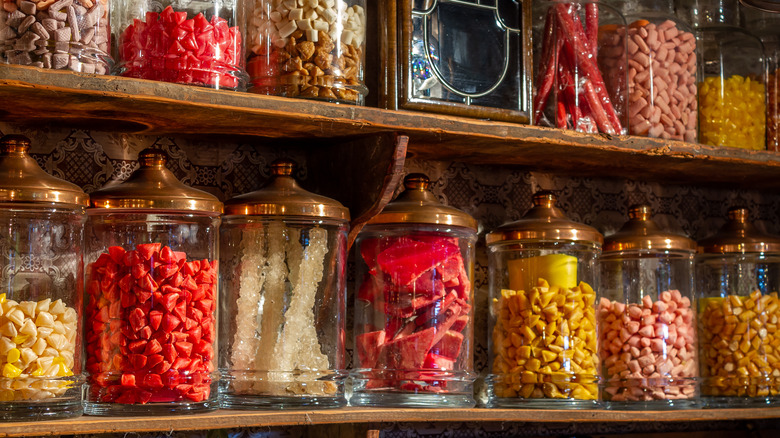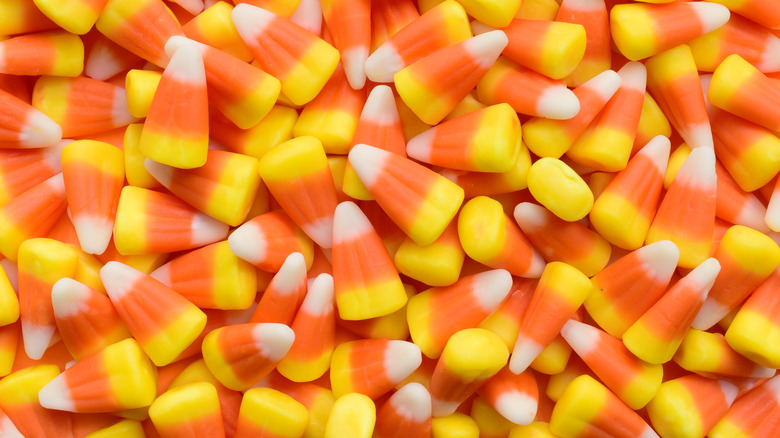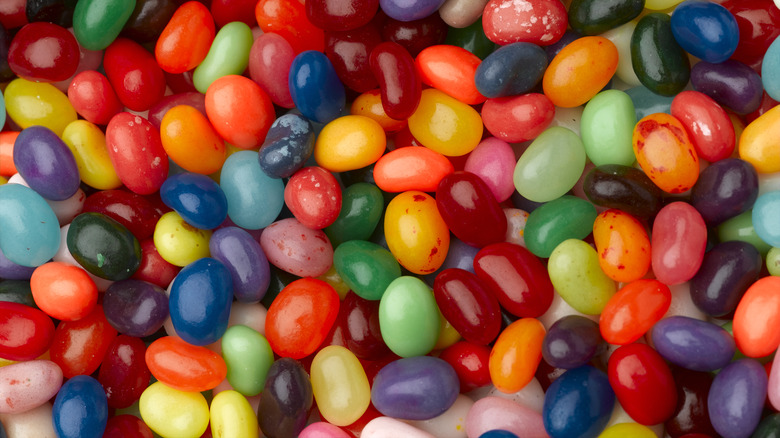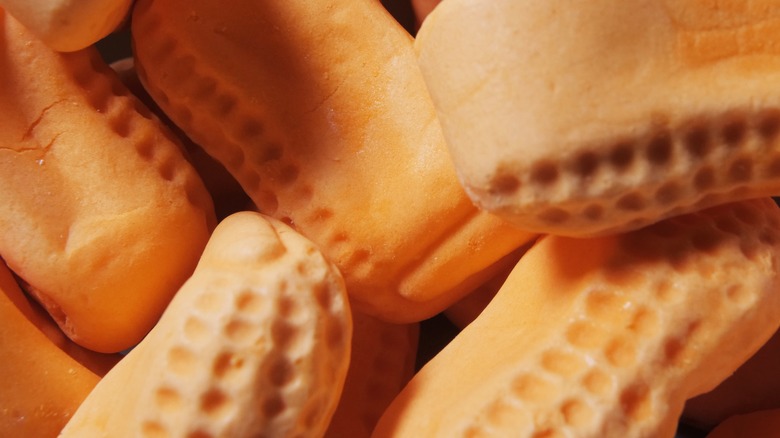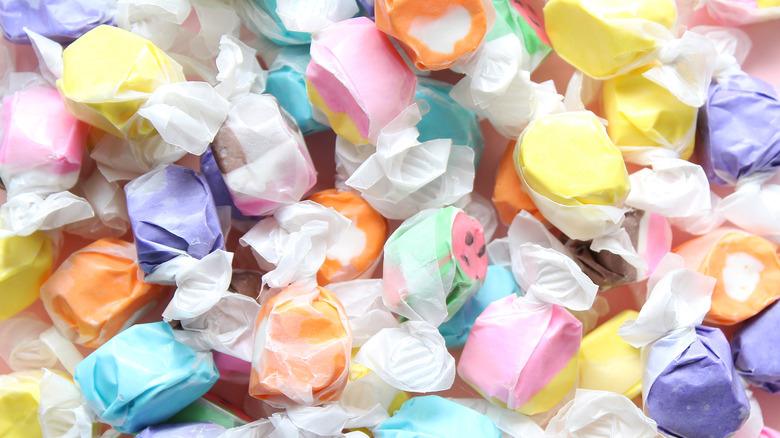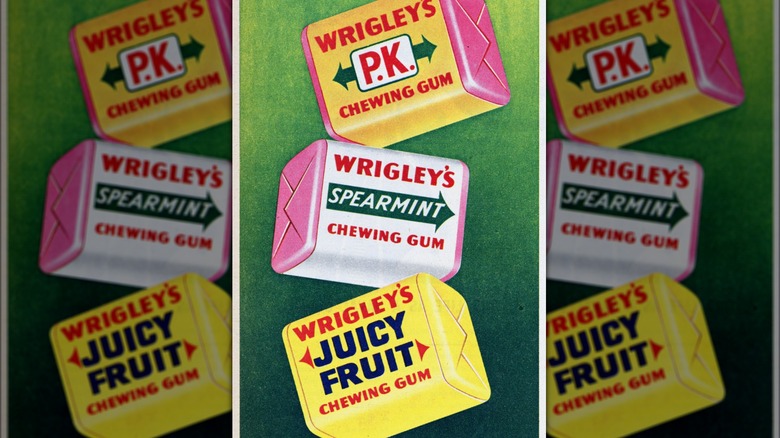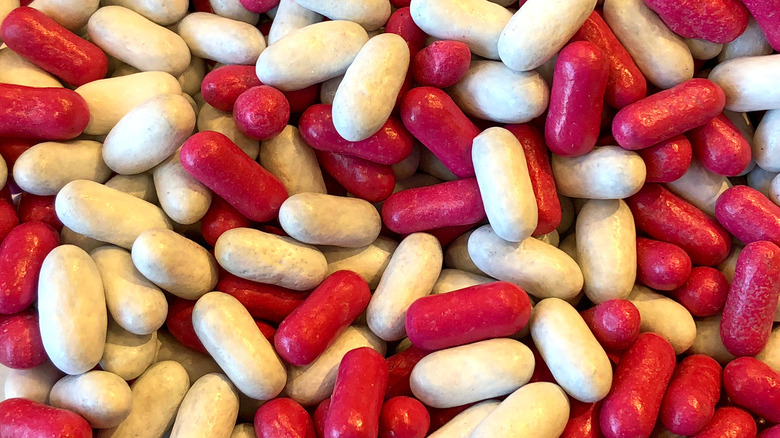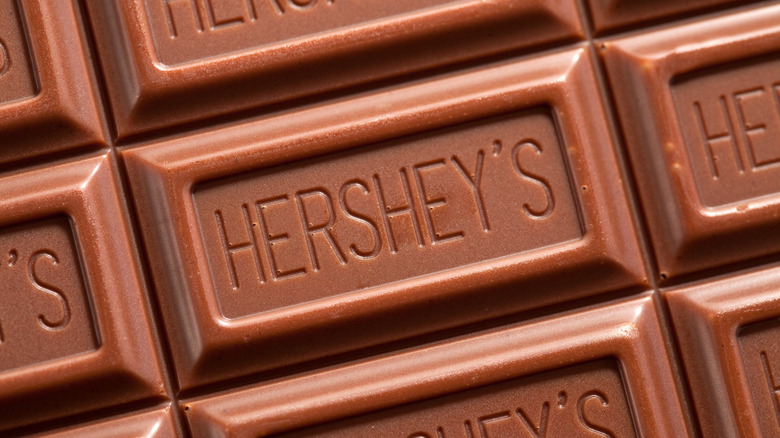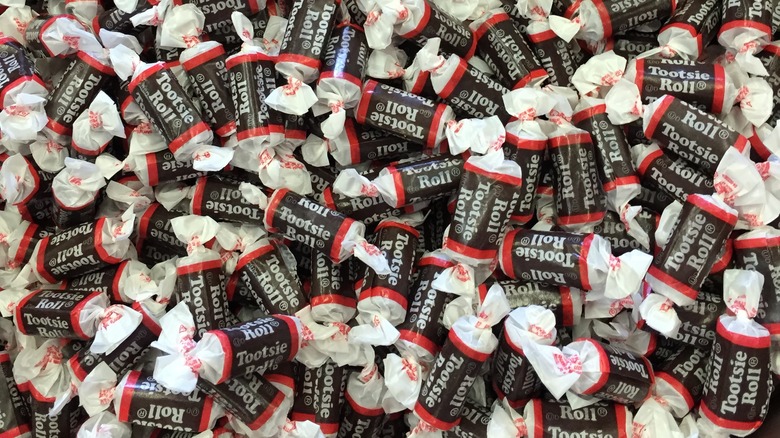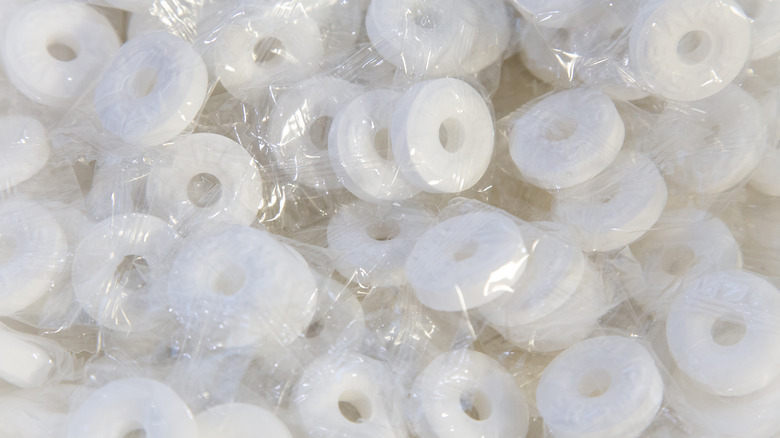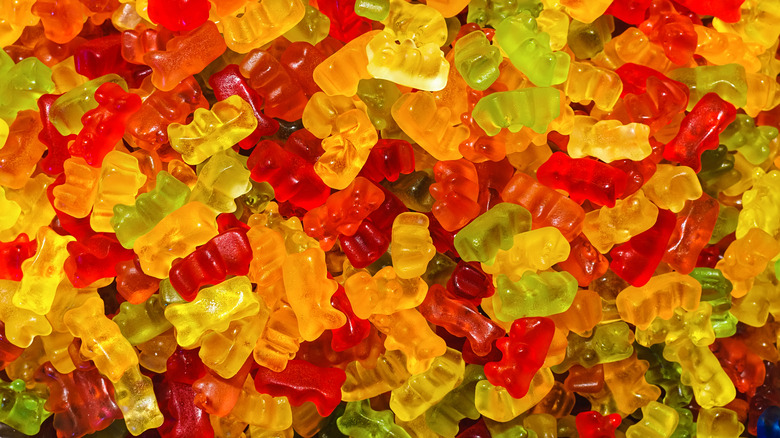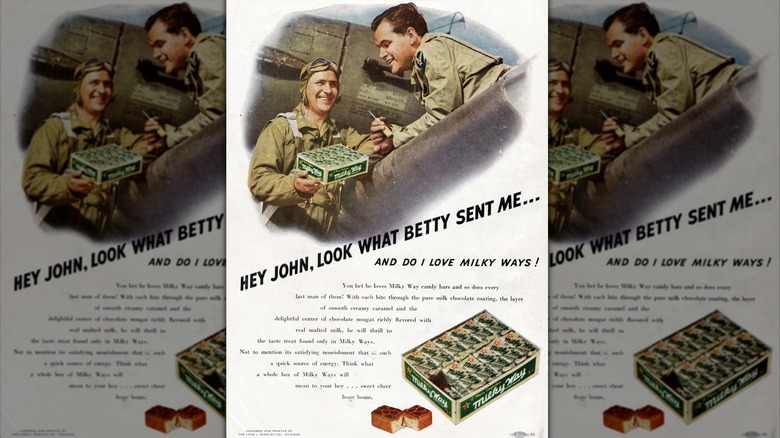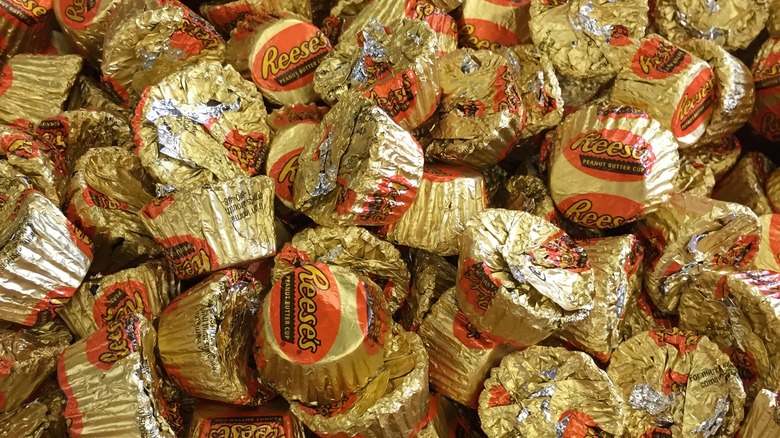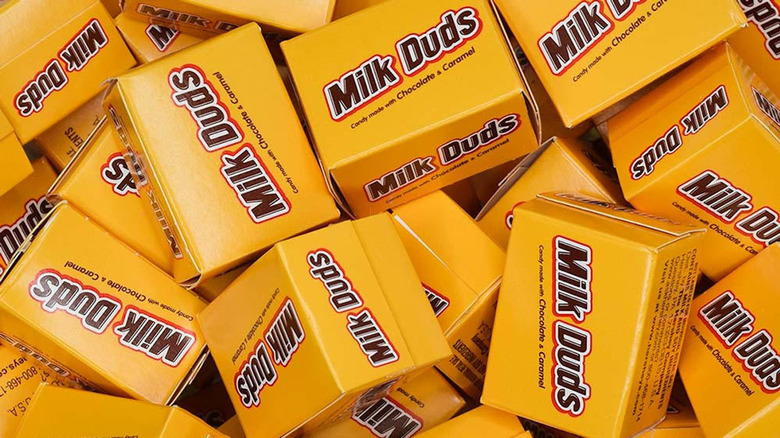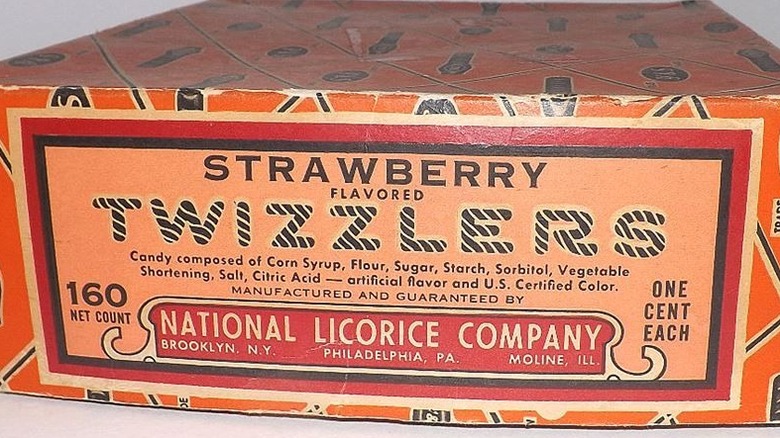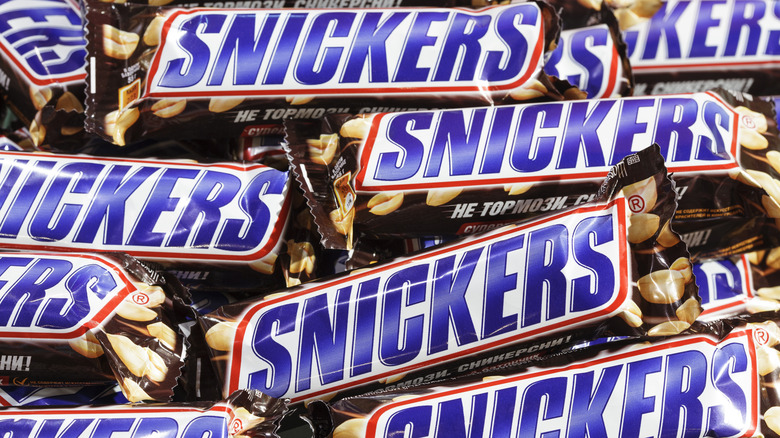15 Candies That Have Been Around Longer Than You'd Think
People have been eating sweet things since time immemorial. Ancient Egyptian hieroglyphics hint at the art of confectionery over 3,000 years ago, though in this time predating the sugar trade, treats were sweetened and dipped in honey. The Mayans were preparing cacao just as long ago, and considered it to be a food of the gods. Confections made from sugar, chocolate, or both have been around for hundreds of years, but industrialization in the 19th century added a new dimension to confectionary possibilities, transforming the art of candy itself into a highly lucrative industry.
The origins behind some of today's oldest, most popular, and even most contested candies are just as often tales of capitalistic scheming as they are stories of dreamers who just wanted to bring smiles with something sweet. Many of today's candies come packaged with seasonal associations and remain popular or prevalent due to the advertising efforts of candy companies that kickstarted trick-or-treating or promoted sweet things for Christmas or Easter.
Here is a list of 15 candies still widely available today that are pushing a century on the market, though many have been enjoyed for much longer. No matter what made them popular, what time of year they are available, or how polarizing their flavors, continued love for these treats speaks to a great unifying human sweet tooth.
1. Candy corn
First sold by Philadelphia's Wunderle Candy Company, candy corn appeared as an American treat in the 1880s as part of a trend of agriculturally-themed sweets targeted towards the farming communities that then made up a significant population of the labor force. These candies were all made of mellowcreme, a mixture of sugar, honey, corn syrup, and food coloring that was molded into far more than mere corn-shaped morsels – pumpkins and turnips were common too.
The tricolor candy corn was a novelty sweet at the time, and very labor-intensive to produce since each separate color had to be molded separately by hand. It wasn't until the Goelitz Candy Company started producing candy corn in 1898 that the candy started to become more popular. The Goelitz family developed a machine that would automatically fill candy corn molds, marketing their sweet as "chicken feed," a name with a nod to the era's assertion that corn was a food for animals rather than people.
In the early 1900s, candy corn could be found in bulk amongst a variety of penny candies available in drugstores, markets, and candy shops. So-called because many pieces could be purchased for one cent, penny candies were particularly popular amongst working-class children. Candy corn was just one of many such bulk sweets that were available year-round, and did not initially have associations with any particular holiday. Perhaps the parallel of corn with fall harvest time contributed to candy corn's inevitable Halloween connection.
2. Jelly beans
Jelly beans come from other jellied descendants. Food historians commonly trace their origins to older jelly candies like Turkish Delight, a Persian sweet that arose in the 1700s served as gelatinous cubes dusted with sugar. Turkish Delight became popular in Europe during the 19th century, perhaps in part because the introduction of corn syrup and man-made gelatin in the 1800s made it possible to produce jelly candies more widely and cheaply.
Though the exact origins of jelly beans are hazy, there may have been advertisements for jelly beans as early as 1861, at the beginning of the American Civil War. Tales suggest that Willliam Schrafft, a Boston candymaker, urged families to send jelly beans to their soldiers fighting for the Union Army. Whether or not the Civil War connection is true, the Goelitz Candy Company also came into existence around this time. While it went on to popularize candy corn, Goelitz became even more renowned for its jelly beans (decades later, the company would become Jelly Belly).
Jelly beans were another popular penny candy in the late 1800s, but gradually garnered association with various holidays. Regarded as more of a Christmas confection in the 1880s, they became associated with Easter by the 1930s, if only because of their ovular shape. While today's candy market does experience a surge in different jelly bean varieties to accommodate springtime hankerings, the Jelly Belly brand of jelly beans is available year-round for those with a sweet tooth that defies seasonality.
3. Marshmallow circus peanuts
Everything about the origins of these soft, chewy, vaguely banana-flavored peanuts is mysteriously murky. It remains unknown why they're shaped like peanuts, why they're typically orange, and whether they were as divisive in the beginning as they've come to be today. What is known is that they surfaced sometime in the 1800s, and were found amongst the other bulk varieties of penny candy prevalent at the time. Whether or not they were ever sold at the circus, the peanut shape is believed to be a nod to the peanuts that had long since been a commonly available circus treat.
Though people may love to hate marshmallow circus peanuts now, rumor has it that one person's passion for them inspired the invention of a breakfast treat that enjoys much more widespread popularity. John Holahan, a General Mills employee, created something entirely new when he chopped up pieces of Circus Peanuts — his favorite candy — and added them to a bowl of Cheerios. Thus the prototype for Lucky Charms was born. While Lucky Charms' flavors and shapes may be different than the peanut predecessor, they have ensured that a legacy of colorful marshmallow treats in the modern world lives on.
4. Salt water taffy
Taffy, a gooey mass of flavored sugar and butter that gets heated and then worked into chewy morsels, was popular in the early 1800s. By the 1870s, according to the Encyclopedia of American Food and Drink, taffy was often made at home — pulling taffy by hand become a popular social activity. At this same point in time, taffy was just as easy to find in the form of individually wrapped penny candies too.
Widely available in Europe and America, taffy didn't become "saltwater taffy" until an allegedly fateful storm that flooded a confectionery shop in Atlantic City, New Jersey. According to the lore, waves infiltrated many businesses along the boardwalk, but shop owner David Bradley was still able to sell his sweets even though they were soaked in seawater. He joked to customers that all he had was "salt water taffy" and the name stuck. But the name persisted as more of a marketing ploy than a change of recipe, as salt water taffy is really no different than any other kind. Taffy recipes have always called for a bit of salt and water among their ingredients, and the outcome is no less sweet.
5. Wrigley's chewing gum
The habit of chewing gum is a fairly ancient practice. Archeological evidence, according to Smithsonian Magazine, suggests that Greek, Scandinavian, Mayan, and Aztec peoples chewed things like birch bark tar and chicle, the resin from a sapodilla tree, many thousands of years ago.
But in more modern history, chewing gum took on a new popularity in the 1800s, becoming mainstream in the 1880s. This was when entrepreneur Thomas Adams Sr. began manufacturing it, producing 5 tons of chewing gum daily to keep up with demand for this innovative new treat.
Seeing an opportunity in 1892, enterprising soap salesman William Wrigley started giving away free chewing gum with his boxes of baking powder. Wrigley's giveaway gum quickly became more popular than any of the other products he was peddling. Seeing a new outlet, Wrigley dropped the soap scheme and pivoted to make a better profit, opting to sell exclusively chewing gum. In 1893 he introduced both Wrigley's Spearmint and Juicy Fruit chewing gum to the world, creating a company that would go on to become the world's largest producer of chewing gum.
6. Good & Plenty
Good & Plenty first arrived during an era when the world had gotten a particular taste for licorice. The two-tone, pastel-hued candy coating may consequently be a bit deceptive, as the flavor of Good & Plenty candy has always been that of black licorice. The brand's name, in fact, is purported to reference the "good and plenty" of licorice flavoring in any given piece.
It was as far back as 1893 that the Quaker City Candy Company had a unique approach to selling anise-adjacent morsels with the innovation of covering bits of licorice with the by-now-familiar pink and white candy coating. Possibly America's oldest continuous candy brand, Good & Plenty was bought by a bigger name nearly 100 years later when Hershey acquired the brand in 1996.
The Washington Post reports a survey from the American Confectioners Association which found that only 3% of people consider black licorice their favorite candy, and references a different survey of various candies which ranked Good & Plenty as the very last. The polarizing flavor that it is, the reliably licorice-flavored Good & Plenty is a box of candy reserved for licorice aficionados only, filled completely with the one flavor most people tend to leave behind.
7. Hershey's
Hershey's got its start in the 1880s and might have become a caramel company if founder Milton S. Hersey hadn't gone to the 1893 Chicago World's Fair. There, he witnessed state-of-the-art chocolate manufacturing machinery and was so inspired he decided to start producing chocolate too. In 1900, Hershey had his first big success with the launch of Hershey's milk chocolate bars, which spurred his official career shift from confectioner to full-on chocolatier.
At only 5 cents a piece due to their mass-produced availability, the original Hershey's chocolate bars were highly accessible to anyone with a hankering for chocolate. In 1907, the first Hershey's Kisses were introduced, painstakingly wrapped by hand until more advanced and automated machinery was capable of wrapping each kiss more efficiently. Bite-sized and individually wrapped, Hershey's Kisses became another popular penny candy. Though no one can say for certain where the kiss title came from, the company gives the explanation that the machine that produced kisses is the reason behind the name, due to the kissing sound it made while spitting out the chocolate morsels.
Today, some of the other brands Hershey has acquired in recent decades may be more widely purchased and internationally renowned, but the iconic Hershey's chocolate has made an appearance in many of the major events of the 20th century. Variants of the Hershey's chocolate bar made it to the front lines of WWII in US troop rations and traveled into space to fortify the astronauts on Apollo 11.
8. Tootsie Rolls
The Tootsie Roll was the brainwave of Leo Hirschfield, an Austrian candy maker in New York who first introduced this chocolate-esque, toffee-adjacent sweet in 1905. Purportedly named after the confectioner's young daughter, whose nickname was "Tootsie", the true innovation of this candy, at the time, was that the flavor toed a never-before-crossed line between two worlds. Until this point, something vaguely chocolate-flavored couldn't successfully exist in a candy shop in summer without melting. But the Tootsie roll, au contraire, could withstand summertime heat just fine — and conveniently came individually wrapped, too.
Finding success and novelty as a penny candy, the Tootsie in Tootsie Rolls was even more popular when introduced in an alternate incarnation, the Tootsie Pop. Invented in 1931, the textural marvel of candy-coated Tootsie on a stick bridged the divide between two worlds yet again, and was a popular treat during the Depression.
Tootsie Rolls took on an even more significant role by the time the U.S. had entered WWII. These candies were included in American soldiers' rations for their additional merit of staying fresh for a long time and provided a quick energy boost for the troops on the front lines. Since then, Tootsie Rolls have retired to become most widely available as a perfectly acceptable Halloween candy when Spooky Season rolls around.
9. Lifesavers
In an early 20th-century world without air-conditioning, chocolate's inconvenient tendency to melt in the summertime heat prompted other candy manufacturers to keep sales up by focusing away from chocolate altogether. This led to the creation of many alternative summer candies that were not affected by higher temperatures. Clarence Crane of Cleveland, Ohio was one such confectioner who found an unusual source of inspiration during a fateful trip to the pharmacy to procure flavor extracts. While there, he was drawn to the pill manufacturing machine, a tablet press that compressed powder into uniform round pills.
Applying this same technology, Crane set out to create a candy in much the same fashion, seeking to produce round peppermints, which was a novelty shape for something minty at the time. In 1912, Lifesavers entered the candy world. Despite some lore that the hole in the middle might allow someone to breathe even if choking on one, Lifesavers are more commonly agreed to be named for their resemblance to life preservers. Crane sold the rights to his company after one year in business, and the candy brand went on to expand.
Mint was the predominant Lifesavers flavor until the 1920s when the company introduced fruit drops. In 1935, this fruity rendition evolved into the roll with five flavors that stand out with recognizable stripes today. Lifesavers rolls were yet another candy included in WWII soldiers' rations, recognizable enough by the 1940s to represent a taste of home. Today they also come individually wrapped.
10. Gummy bears
Gummy bears have been synonymous with HARIBO since 1922, when Hans Riegel first crafted them in Bonn, Germany. The globally renowned candy company that would evolve from this endeavor is named for an acronym from his first and last name and the city where the candy got its start.
The gummy texture of these bears was nothing out of the ordinary. Reigel's candy followed the precedent of jellied forebears like Turkish delight, gum drops, and jelly beans. Gummy bears were an innovation simply because of their shape. Riegel found his inspiration for the candy bears in the dancing bears that comprised a popular European entertainment since the Middle Ages. Though the sweet little bears were intended to conjure nostalgic reflections of this childhood entertainment, the pseudo-circus act has a troubling past – the industry surrounding dancing bears was driven by poaching and animal cruelty. In 1960, HARIBO rebranded its dancing bears to call them Goldbears instead, offering them in the pack of 5 flavors we all recognize today.
HARIBO gummy bears were instantly popular, but their success reached an impasse during WWII. In 1945, Reigel himself died, and his sons, fighting for Germany, were sent to American prisoner-of-war camps. With production nearly at a halt, it wasn't until after the war that the company gained traction again, with Reigel's sons transforming it into a global candy force. Though other brands and flavors of gummy bears exist today, HARIBO's five-colored Goldbears remain the most recognizable.
11. Milky Ways
Frank Mars of Minneapolis, Minnesota had his first success as a candy maker with The Mars Candy Company when he introduced the Milky Way in 1923. Despite sharing the same name as our local galaxy, the candy bar isn't actually named for anything celestial. The "milk" in Milky Way references the malted milk that features as a primary ingredient. Malted milk, a powder made from evaporated milk and malted barley, was considered an easily digestible source of nutrients for children and invalids when it first hit the market in the late 1800s. Soda fountains eventually popularized this nutrient by adding more than a spoonful of sugar to the nutty-flavored medicine powder — when combined with some milk and a few scoops of ice cream, the malted shake was born.
Capitalizing on the health food origins of the milkshake, Frank Mars advertised that each Milky Way bar had more malted milk than any malted beverage at the soda fountain. Though these candy bars took advantage of a health trend, Mars' son Forrest claimed to have come up with the idea when he was a boy, simply suggesting to his father one day at an ice cream parlor that they should make a candy bar that tasted like a malted milkshake. Until Mars started making its own chocolate coating in the 1960s, the original Milky Way bars were covered with Hershey's chocolate. Swathing alleged health with milk chocolate deliciousness, it's no wonder the Milky Way was an instant success.
12. Reese's Peanut Butter Cups
When peanut butter was first introduced to the world in the late 1800s, it was regarded as a luxury food. Once technologies advanced to produce peanut butter on an industrial scale, it became a health food for the masses. Rich in protein and calories, it was an efficient source of energy during a time when many working-class people in America still struggled with malnutrition.
It was probably only a matter of time before someone thought to combine peanut butter and chocolate — peanut butter cups themselves have been around since as early as 1907. But it was Harry Burnett Reese, a former Hershey's employee, who ensured their widespread popularity when he decided to start his own candy company after WWI. Hershey gave the budding chocolatier his blessing with the agreement that the H.B. Reese Candy Company would use exclusively Hershey's chocolate.
Reese added peanut butter cups to his candy arsenal in 1928, accidentally creating a distinct taste with manufacturing equipment that roasted the peanuts for peanut butter until they were practically burnt. At the height of WWII rationing, Reese's candy company was forced to limit production. Taking a gamble, Reese decided to manufacture only peanut butter cups — they required less sugar (which was then a severely rationed commodity) since they were made with mostly peanut butter (which remained in ample supply). Instantly popular, the winning combination of peanut butter and Hershey's chocolate was immortalized when Hershey's bought Reese's candy company in 1963.
13. Milk Duds
When the M.J. Holloway Candy Co. introduced Milk Duds in the late 1920s, the misshapen treats were suspected to be an underdog in the candy world. The name itself was a joke about the candy's imperfect shape. Milton Holloway, the company founder who operated the candy business out of Chicago, had set out to produce perfectly round chocolate-covered caramels, but to no avail. Caramel proved to be an unwieldy filling for candy-making, and unsuccessful production efforts only yielded irregularly shaped candies. But the flavor, fortunately, was no less delicious, so Holloway decided to box up the "duds" anyway. While in command of the company, Holloway would eat Milk Duds every day to ensure the mass-produced duds were anything but.
Despite the dubious appellation, Milk Duds were a hit, and they remained popular even when the Depression hit America a few years later. In fact, during the Depression, demand only continued to rise. A popular movie theater candy from the beginning, a box of Milk Duds was available at concession stands for a mere 5 cents. Many working men would head straight to the movie theater from work, where they could purchase a box of Milk Duds that would sustain them for a few hours, keeping the Milk Dud business booming even during an era of scarcity. Hershey's bought the brand in 1996, and though no longer 5 cents a pop, Milk Duds remain a popular movie theater treat, ranking third in a survey of go-to movie theater candies.
14. Twizzlers
With company origins dating back to the 1840s, Twizzlers came from a candy company that made its niche in licorice. Based in Brooklyn, Young & Smylie produced licorice candies in all shapes, sizes, and textures. In 1902 Young & Smylie merged with a pair of different candy producers to become the National Licorice Company. A few decades later, this licorice mogul introduced Twizzlers. Though the ironically non-licorice-flavored treat came out in 1929, it didn't become mainstream until the 1970s. Perhaps this was because Twizzlers were produced by a company whose name suggested a strong allegiance to licorice, a flavor that has long since been divisive amongst sweet tooths. Coinciding with the sudden rise in Twizzler's consumption is the fact that the National Licorice Company changed its name back to Y&S Candies in the 1970s, a more neutral title that didn't automatically scare licorice haters away.
Hershey's bought the Twizzlers brand in the 70s, just as it was becoming popular, and modified the recipe into the vaguely strawberry-infused twists we know today. A candy that remains polarizing in terms of both flavor and texture (the debate over Twizzlers versus Red Vines rages on) Twizzlers still remain another go-to choice amongst movie theater concessions.
15. Snickers
Introduced in 1930 as another creation of the Mars Candy Company, Snickers was born out of Mars' first candy triumph with the Milky Way. Celebrating their sweet and financial success, Mars and his wife bought a horse breeding farm. While Mars and his wife were in the process of concocting the next big candy bar hit, their favorite horse, named Snickers, died suddenly. As the story goes, with no name yet decided on this next candy bar incorporating chocolate, peanuts, and caramel, the new candy was named in Snickers' honor.
Though this has always been a recognizable name in the United States, Snickers was originally known as the "Marathon Bar" in the UK. It was given this alternate title for fear of impropriety overseas with a name that rhymed with "knickers," the British term for underwear. Since 1990, the names for this candy across the globe have been changed to the universal Snickers, and the same bar by any name tastes just as sweet. According to a survey from Statista, Snickers, nearly 100 years later, remains the number one most popular chocolate candy in America, and following Insider Monkey's statistics, may in fact be the most popular candy in the world.
